NUR3201 Health Risk Management Report: Case Study of Troy Almond
VerifiedAdded on 2022/09/26
|6
|1363
|17
Report
AI Summary
This report provides a detailed analysis of health risk management within the healthcare context, using the case of Troy Almond as a focal point. It examines critical aspects such as the importance of evidence-based practice, particularly in pediatric care, and the crucial role of healthcare professionals, including nurses and doctors, in mitigating risks. The report highlights the significance of accurate documentation in electronic medical records, emphasizing the need for proper assessment of vital signs and timely communication. The analysis delves into missed opportunities in the case, such as the failure to follow established protocols like the 'Paediatric Sepsis Pathway' and the lack of effective communication with the patient's mother. Furthermore, it discusses the incorporation of patient safety initiatives like 'Ryan's Rule' to address these shortcomings. The report underscores the importance of clear communication, coordination among healthcare teams, and the integration of patient and carer concerns to ensure better patient outcomes and prevent adverse events.
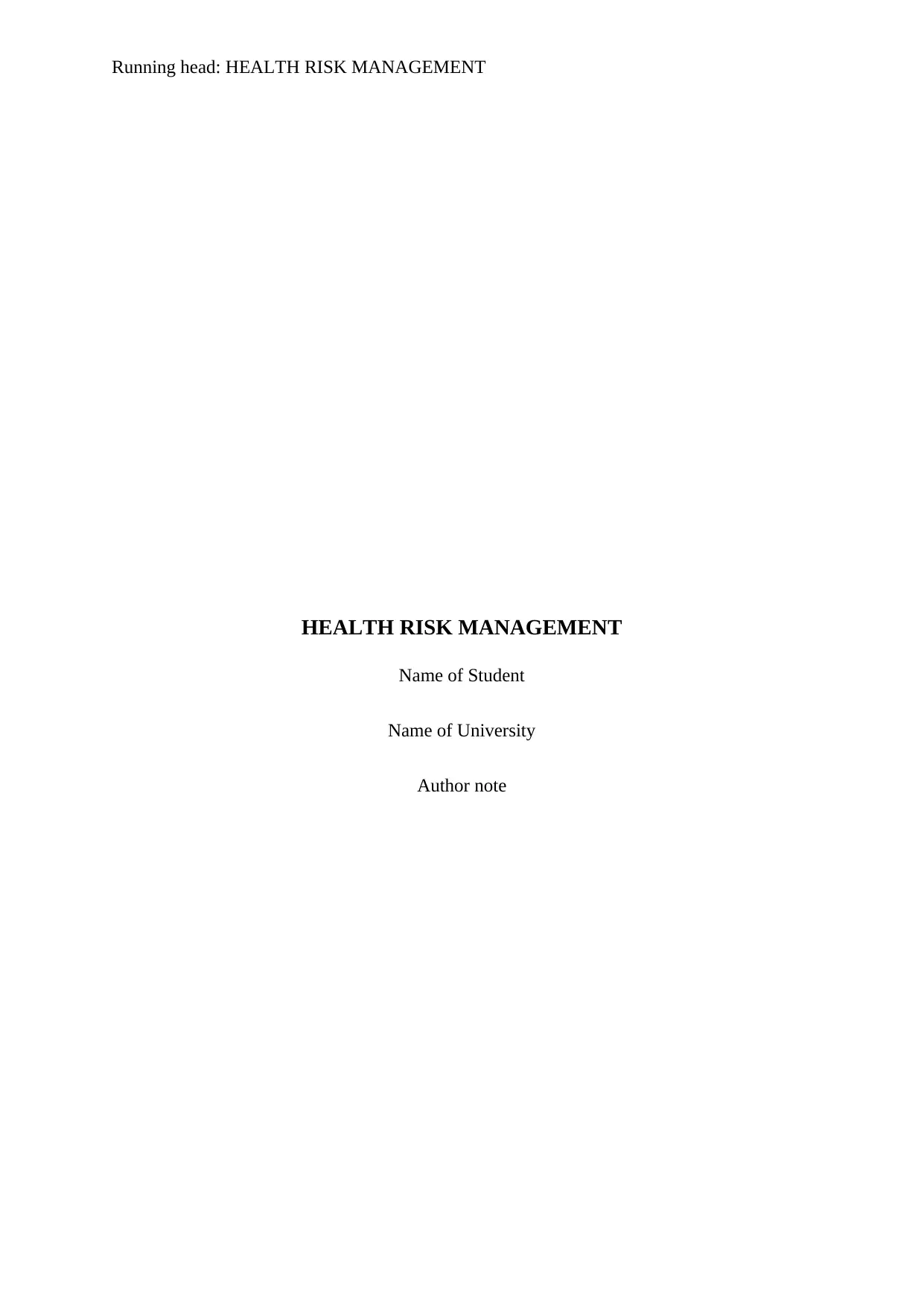
Running head: HEALTH RISK MANAGEMENT
HEALTH RISK MANAGEMENT
Name of Student
Name of University
Author note
HEALTH RISK MANAGEMENT
Name of Student
Name of University
Author note
Paraphrase This Document
Need a fresh take? Get an instant paraphrase of this document with our AI Paraphraser
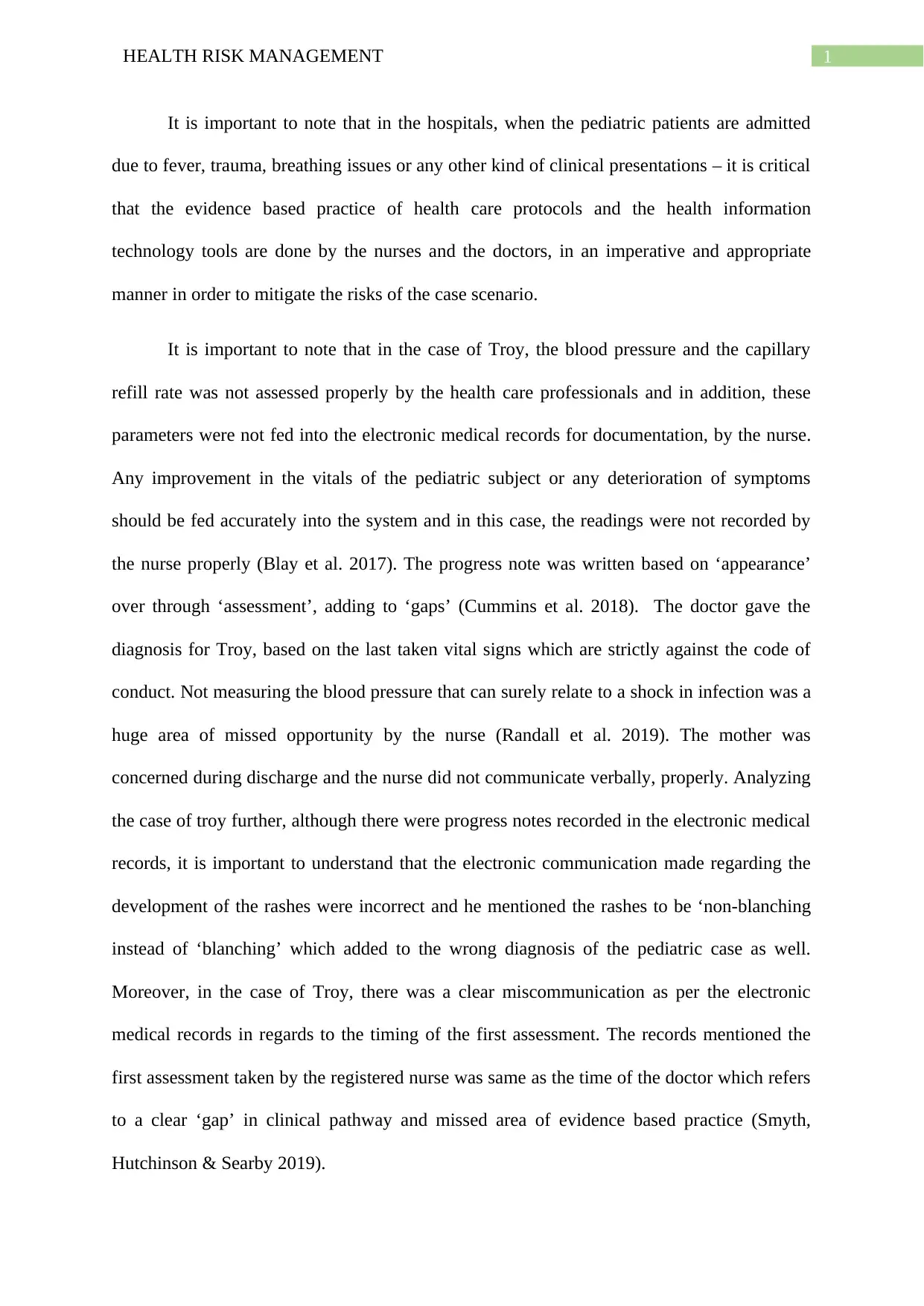
1HEALTH RISK MANAGEMENT
It is important to note that in the hospitals, when the pediatric patients are admitted
due to fever, trauma, breathing issues or any other kind of clinical presentations – it is critical
that the evidence based practice of health care protocols and the health information
technology tools are done by the nurses and the doctors, in an imperative and appropriate
manner in order to mitigate the risks of the case scenario.
It is important to note that in the case of Troy, the blood pressure and the capillary
refill rate was not assessed properly by the health care professionals and in addition, these
parameters were not fed into the electronic medical records for documentation, by the nurse.
Any improvement in the vitals of the pediatric subject or any deterioration of symptoms
should be fed accurately into the system and in this case, the readings were not recorded by
the nurse properly (Blay et al. 2017). The progress note was written based on ‘appearance’
over through ‘assessment’, adding to ‘gaps’ (Cummins et al. 2018). The doctor gave the
diagnosis for Troy, based on the last taken vital signs which are strictly against the code of
conduct. Not measuring the blood pressure that can surely relate to a shock in infection was a
huge area of missed opportunity by the nurse (Randall et al. 2019). The mother was
concerned during discharge and the nurse did not communicate verbally, properly. Analyzing
the case of troy further, although there were progress notes recorded in the electronic medical
records, it is important to understand that the electronic communication made regarding the
development of the rashes were incorrect and he mentioned the rashes to be ‘non-blanching
instead of ‘blanching’ which added to the wrong diagnosis of the pediatric case as well.
Moreover, in the case of Troy, there was a clear miscommunication as per the electronic
medical records in regards to the timing of the first assessment. The records mentioned the
first assessment taken by the registered nurse was same as the time of the doctor which refers
to a clear ‘gap’ in clinical pathway and missed area of evidence based practice (Smyth,
Hutchinson & Searby 2019).
It is important to note that in the hospitals, when the pediatric patients are admitted
due to fever, trauma, breathing issues or any other kind of clinical presentations – it is critical
that the evidence based practice of health care protocols and the health information
technology tools are done by the nurses and the doctors, in an imperative and appropriate
manner in order to mitigate the risks of the case scenario.
It is important to note that in the case of Troy, the blood pressure and the capillary
refill rate was not assessed properly by the health care professionals and in addition, these
parameters were not fed into the electronic medical records for documentation, by the nurse.
Any improvement in the vitals of the pediatric subject or any deterioration of symptoms
should be fed accurately into the system and in this case, the readings were not recorded by
the nurse properly (Blay et al. 2017). The progress note was written based on ‘appearance’
over through ‘assessment’, adding to ‘gaps’ (Cummins et al. 2018). The doctor gave the
diagnosis for Troy, based on the last taken vital signs which are strictly against the code of
conduct. Not measuring the blood pressure that can surely relate to a shock in infection was a
huge area of missed opportunity by the nurse (Randall et al. 2019). The mother was
concerned during discharge and the nurse did not communicate verbally, properly. Analyzing
the case of troy further, although there were progress notes recorded in the electronic medical
records, it is important to understand that the electronic communication made regarding the
development of the rashes were incorrect and he mentioned the rashes to be ‘non-blanching
instead of ‘blanching’ which added to the wrong diagnosis of the pediatric case as well.
Moreover, in the case of Troy, there was a clear miscommunication as per the electronic
medical records in regards to the timing of the first assessment. The records mentioned the
first assessment taken by the registered nurse was same as the time of the doctor which refers
to a clear ‘gap’ in clinical pathway and missed area of evidence based practice (Smyth,
Hutchinson & Searby 2019).
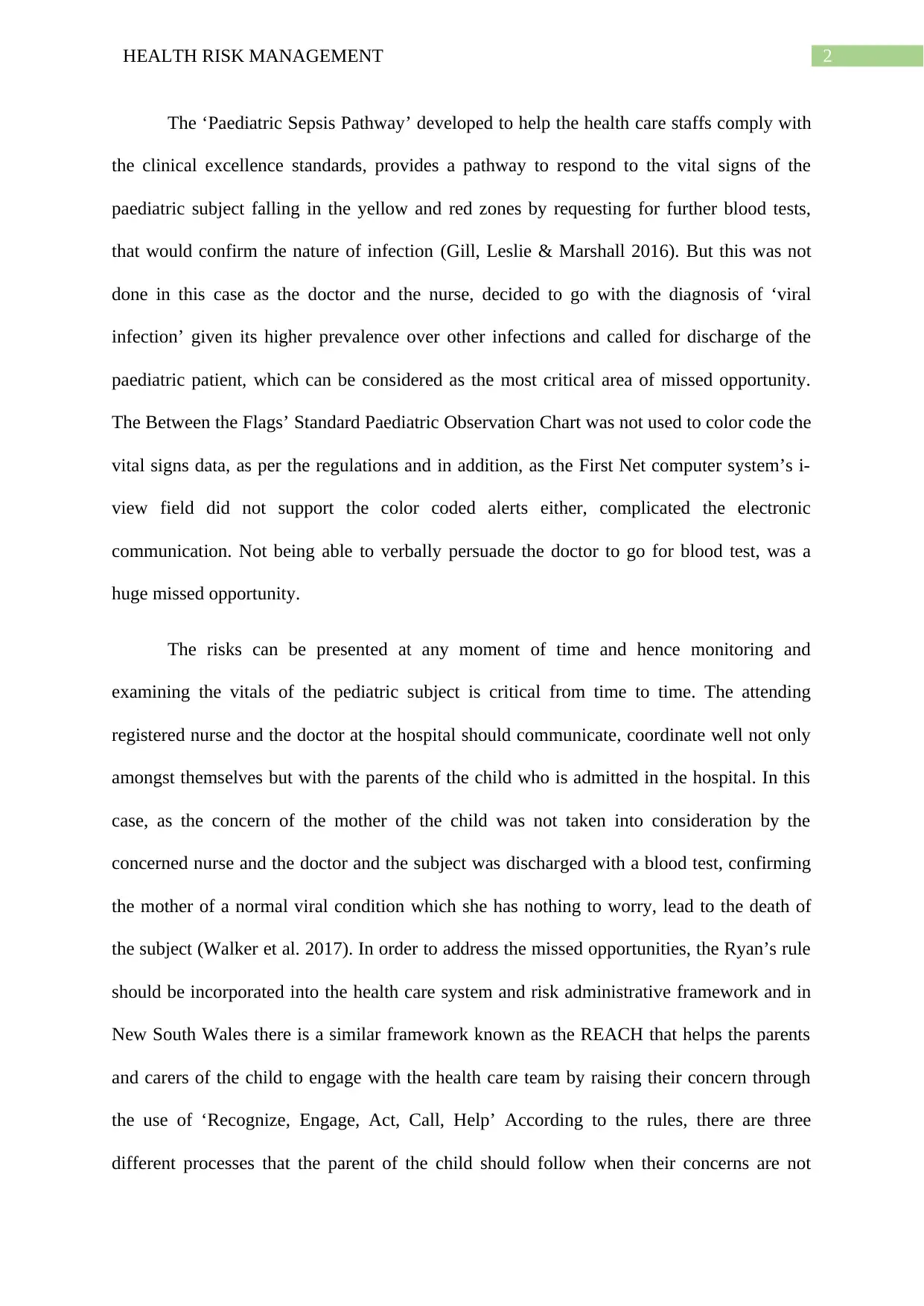
2HEALTH RISK MANAGEMENT
The ‘Paediatric Sepsis Pathway’ developed to help the health care staffs comply with
the clinical excellence standards, provides a pathway to respond to the vital signs of the
paediatric subject falling in the yellow and red zones by requesting for further blood tests,
that would confirm the nature of infection (Gill, Leslie & Marshall 2016). But this was not
done in this case as the doctor and the nurse, decided to go with the diagnosis of ‘viral
infection’ given its higher prevalence over other infections and called for discharge of the
paediatric patient, which can be considered as the most critical area of missed opportunity.
The Between the Flags’ Standard Paediatric Observation Chart was not used to color code the
vital signs data, as per the regulations and in addition, as the First Net computer system’s i-
view field did not support the color coded alerts either, complicated the electronic
communication. Not being able to verbally persuade the doctor to go for blood test, was a
huge missed opportunity.
The risks can be presented at any moment of time and hence monitoring and
examining the vitals of the pediatric subject is critical from time to time. The attending
registered nurse and the doctor at the hospital should communicate, coordinate well not only
amongst themselves but with the parents of the child who is admitted in the hospital. In this
case, as the concern of the mother of the child was not taken into consideration by the
concerned nurse and the doctor and the subject was discharged with a blood test, confirming
the mother of a normal viral condition which she has nothing to worry, lead to the death of
the subject (Walker et al. 2017). In order to address the missed opportunities, the Ryan’s rule
should be incorporated into the health care system and risk administrative framework and in
New South Wales there is a similar framework known as the REACH that helps the parents
and carers of the child to engage with the health care team by raising their concern through
the use of ‘Recognize, Engage, Act, Call, Help’ According to the rules, there are three
different processes that the parent of the child should follow when their concerns are not
The ‘Paediatric Sepsis Pathway’ developed to help the health care staffs comply with
the clinical excellence standards, provides a pathway to respond to the vital signs of the
paediatric subject falling in the yellow and red zones by requesting for further blood tests,
that would confirm the nature of infection (Gill, Leslie & Marshall 2016). But this was not
done in this case as the doctor and the nurse, decided to go with the diagnosis of ‘viral
infection’ given its higher prevalence over other infections and called for discharge of the
paediatric patient, which can be considered as the most critical area of missed opportunity.
The Between the Flags’ Standard Paediatric Observation Chart was not used to color code the
vital signs data, as per the regulations and in addition, as the First Net computer system’s i-
view field did not support the color coded alerts either, complicated the electronic
communication. Not being able to verbally persuade the doctor to go for blood test, was a
huge missed opportunity.
The risks can be presented at any moment of time and hence monitoring and
examining the vitals of the pediatric subject is critical from time to time. The attending
registered nurse and the doctor at the hospital should communicate, coordinate well not only
amongst themselves but with the parents of the child who is admitted in the hospital. In this
case, as the concern of the mother of the child was not taken into consideration by the
concerned nurse and the doctor and the subject was discharged with a blood test, confirming
the mother of a normal viral condition which she has nothing to worry, lead to the death of
the subject (Walker et al. 2017). In order to address the missed opportunities, the Ryan’s rule
should be incorporated into the health care system and risk administrative framework and in
New South Wales there is a similar framework known as the REACH that helps the parents
and carers of the child to engage with the health care team by raising their concern through
the use of ‘Recognize, Engage, Act, Call, Help’ According to the rules, there are three
different processes that the parent of the child should follow when their concerns are not
⊘ This is a preview!⊘
Do you want full access?
Subscribe today to unlock all pages.

Trusted by 1+ million students worldwide
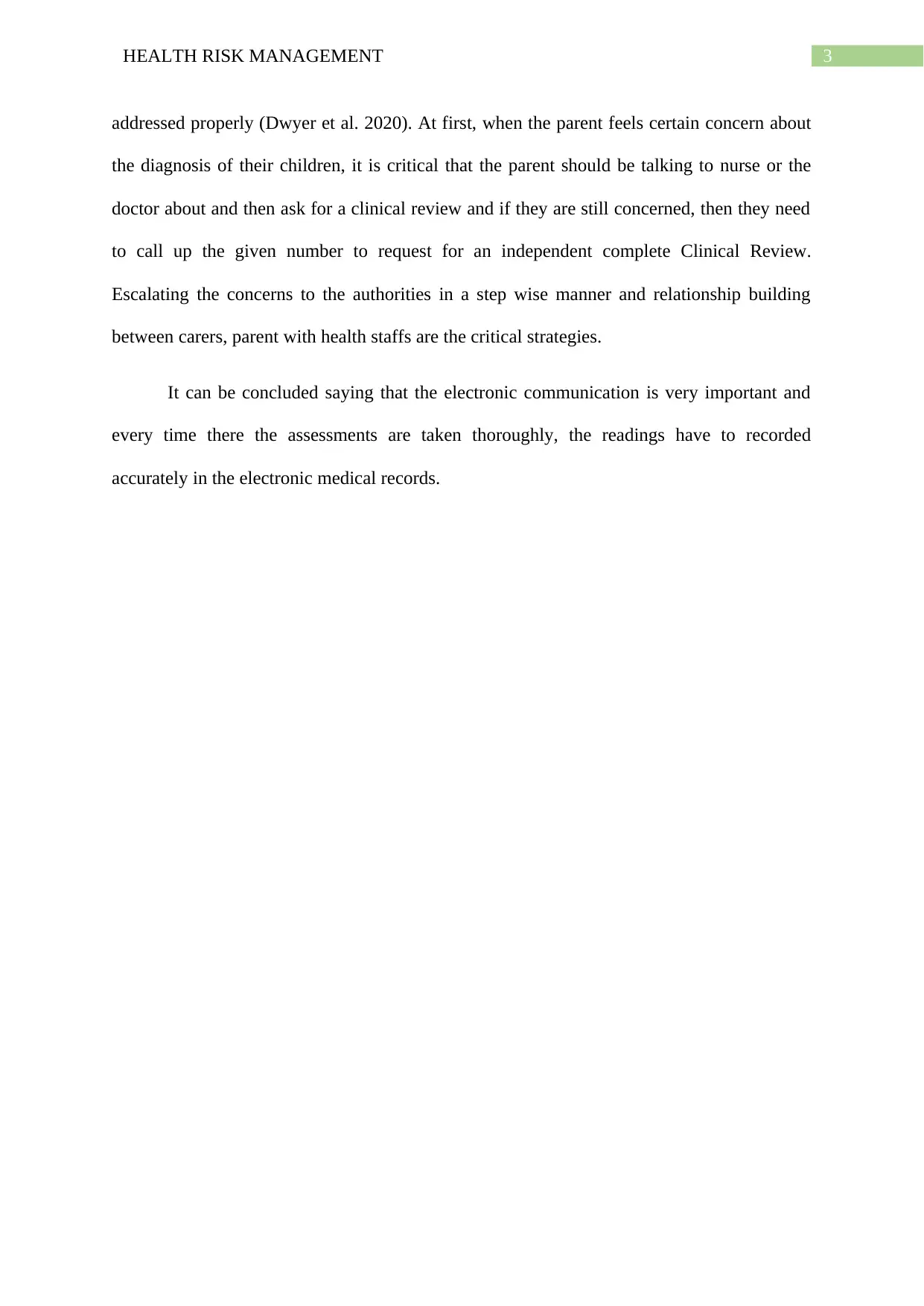
3HEALTH RISK MANAGEMENT
addressed properly (Dwyer et al. 2020). At first, when the parent feels certain concern about
the diagnosis of their children, it is critical that the parent should be talking to nurse or the
doctor about and then ask for a clinical review and if they are still concerned, then they need
to call up the given number to request for an independent complete Clinical Review.
Escalating the concerns to the authorities in a step wise manner and relationship building
between carers, parent with health staffs are the critical strategies.
It can be concluded saying that the electronic communication is very important and
every time there the assessments are taken thoroughly, the readings have to recorded
accurately in the electronic medical records.
addressed properly (Dwyer et al. 2020). At first, when the parent feels certain concern about
the diagnosis of their children, it is critical that the parent should be talking to nurse or the
doctor about and then ask for a clinical review and if they are still concerned, then they need
to call up the given number to request for an independent complete Clinical Review.
Escalating the concerns to the authorities in a step wise manner and relationship building
between carers, parent with health staffs are the critical strategies.
It can be concluded saying that the electronic communication is very important and
every time there the assessments are taken thoroughly, the readings have to recorded
accurately in the electronic medical records.
Paraphrase This Document
Need a fresh take? Get an instant paraphrase of this document with our AI Paraphraser
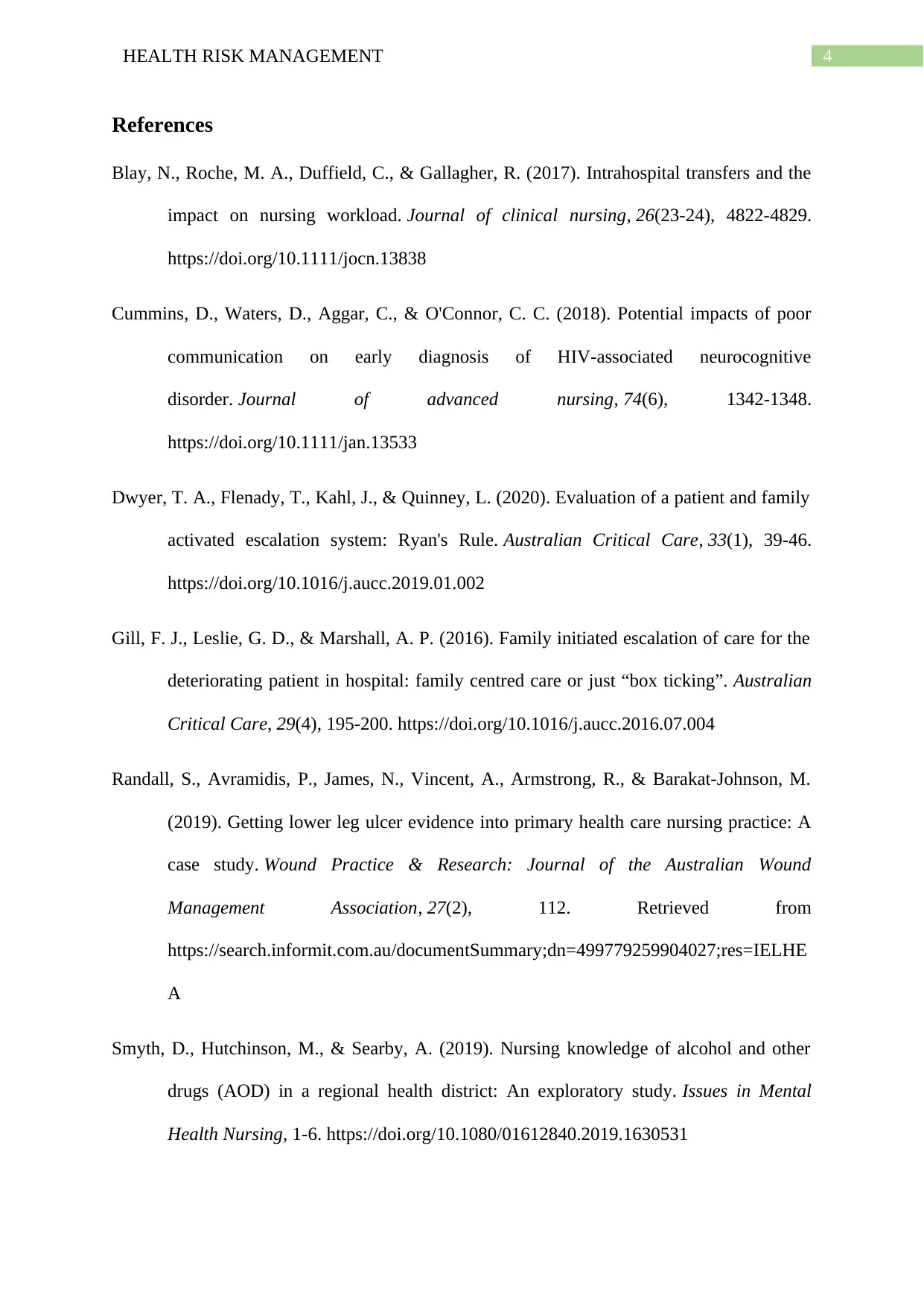
4HEALTH RISK MANAGEMENT
References
Blay, N., Roche, M. A., Duffield, C., & Gallagher, R. (2017). Intrahospital transfers and the
impact on nursing workload. Journal of clinical nursing, 26(23-24), 4822-4829.
https://doi.org/10.1111/jocn.13838
Cummins, D., Waters, D., Aggar, C., & O'Connor, C. C. (2018). Potential impacts of poor
communication on early diagnosis of HIV‐associated neurocognitive
disorder. Journal of advanced nursing, 74(6), 1342-1348.
https://doi.org/10.1111/jan.13533
Dwyer, T. A., Flenady, T., Kahl, J., & Quinney, L. (2020). Evaluation of a patient and family
activated escalation system: Ryan's Rule. Australian Critical Care, 33(1), 39-46.
https://doi.org/10.1016/j.aucc.2019.01.002
Gill, F. J., Leslie, G. D., & Marshall, A. P. (2016). Family initiated escalation of care for the
deteriorating patient in hospital: family centred care or just “box ticking”. Australian
Critical Care, 29(4), 195-200. https://doi.org/10.1016/j.aucc.2016.07.004
Randall, S., Avramidis, P., James, N., Vincent, A., Armstrong, R., & Barakat-Johnson, M.
(2019). Getting lower leg ulcer evidence into primary health care nursing practice: A
case study. Wound Practice & Research: Journal of the Australian Wound
Management Association, 27(2), 112. Retrieved from
https://search.informit.com.au/documentSummary;dn=499779259904027;res=IELHE
A
Smyth, D., Hutchinson, M., & Searby, A. (2019). Nursing knowledge of alcohol and other
drugs (AOD) in a regional health district: An exploratory study. Issues in Mental
Health Nursing, 1-6. https://doi.org/10.1080/01612840.2019.1630531
References
Blay, N., Roche, M. A., Duffield, C., & Gallagher, R. (2017). Intrahospital transfers and the
impact on nursing workload. Journal of clinical nursing, 26(23-24), 4822-4829.
https://doi.org/10.1111/jocn.13838
Cummins, D., Waters, D., Aggar, C., & O'Connor, C. C. (2018). Potential impacts of poor
communication on early diagnosis of HIV‐associated neurocognitive
disorder. Journal of advanced nursing, 74(6), 1342-1348.
https://doi.org/10.1111/jan.13533
Dwyer, T. A., Flenady, T., Kahl, J., & Quinney, L. (2020). Evaluation of a patient and family
activated escalation system: Ryan's Rule. Australian Critical Care, 33(1), 39-46.
https://doi.org/10.1016/j.aucc.2019.01.002
Gill, F. J., Leslie, G. D., & Marshall, A. P. (2016). Family initiated escalation of care for the
deteriorating patient in hospital: family centred care or just “box ticking”. Australian
Critical Care, 29(4), 195-200. https://doi.org/10.1016/j.aucc.2016.07.004
Randall, S., Avramidis, P., James, N., Vincent, A., Armstrong, R., & Barakat-Johnson, M.
(2019). Getting lower leg ulcer evidence into primary health care nursing practice: A
case study. Wound Practice & Research: Journal of the Australian Wound
Management Association, 27(2), 112. Retrieved from
https://search.informit.com.au/documentSummary;dn=499779259904027;res=IELHE
A
Smyth, D., Hutchinson, M., & Searby, A. (2019). Nursing knowledge of alcohol and other
drugs (AOD) in a regional health district: An exploratory study. Issues in Mental
Health Nursing, 1-6. https://doi.org/10.1080/01612840.2019.1630531
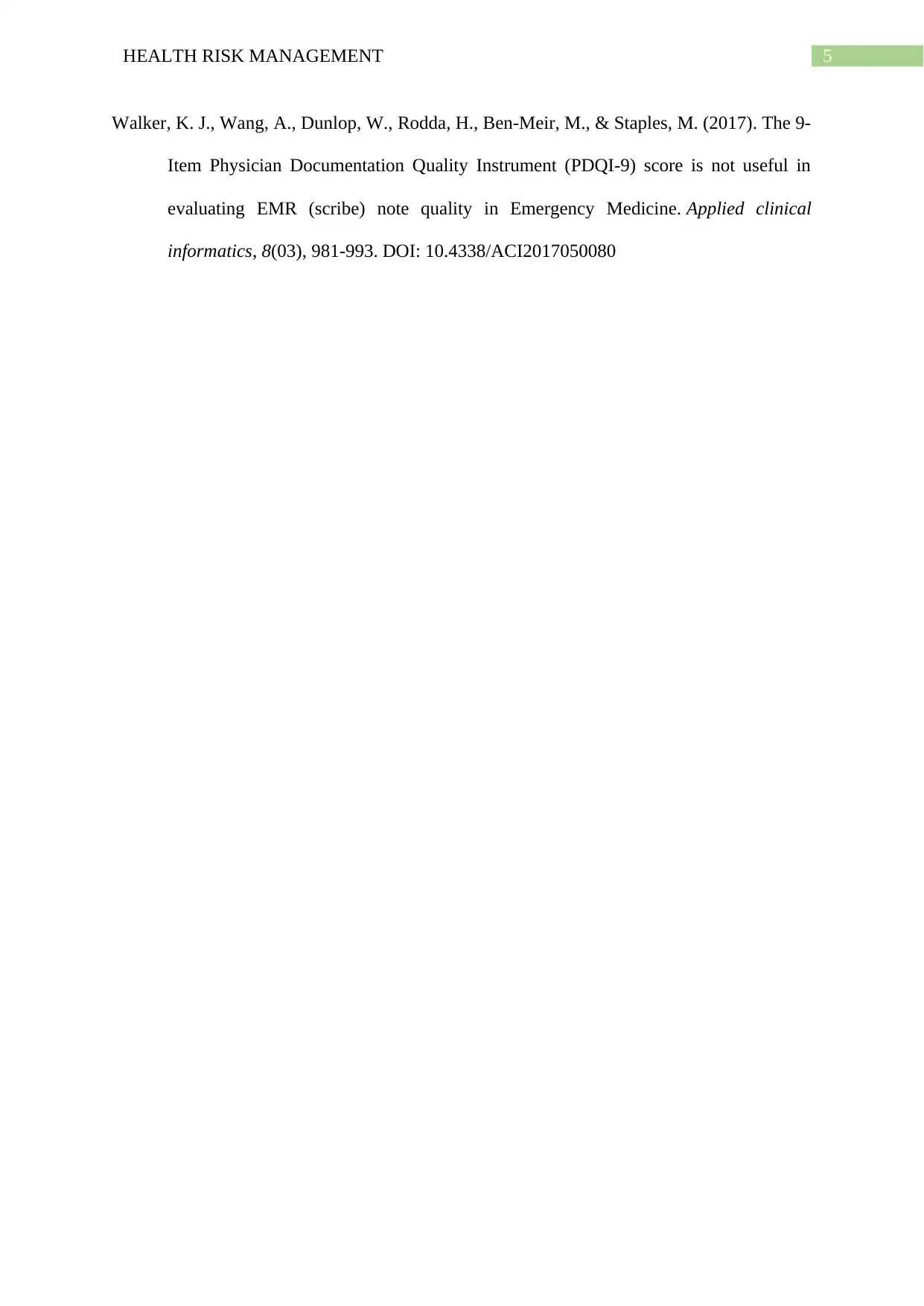
5HEALTH RISK MANAGEMENT
Walker, K. J., Wang, A., Dunlop, W., Rodda, H., Ben-Meir, M., & Staples, M. (2017). The 9-
Item Physician Documentation Quality Instrument (PDQI-9) score is not useful in
evaluating EMR (scribe) note quality in Emergency Medicine. Applied clinical
informatics, 8(03), 981-993. DOI: 10.4338/ACI2017050080
Walker, K. J., Wang, A., Dunlop, W., Rodda, H., Ben-Meir, M., & Staples, M. (2017). The 9-
Item Physician Documentation Quality Instrument (PDQI-9) score is not useful in
evaluating EMR (scribe) note quality in Emergency Medicine. Applied clinical
informatics, 8(03), 981-993. DOI: 10.4338/ACI2017050080
⊘ This is a preview!⊘
Do you want full access?
Subscribe today to unlock all pages.

Trusted by 1+ million students worldwide
1 out of 6
Related Documents
Your All-in-One AI-Powered Toolkit for Academic Success.
+13062052269
info@desklib.com
Available 24*7 on WhatsApp / Email
![[object Object]](/_next/static/media/star-bottom.7253800d.svg)
Unlock your academic potential
Copyright © 2020–2025 A2Z Services. All Rights Reserved. Developed and managed by ZUCOL.





